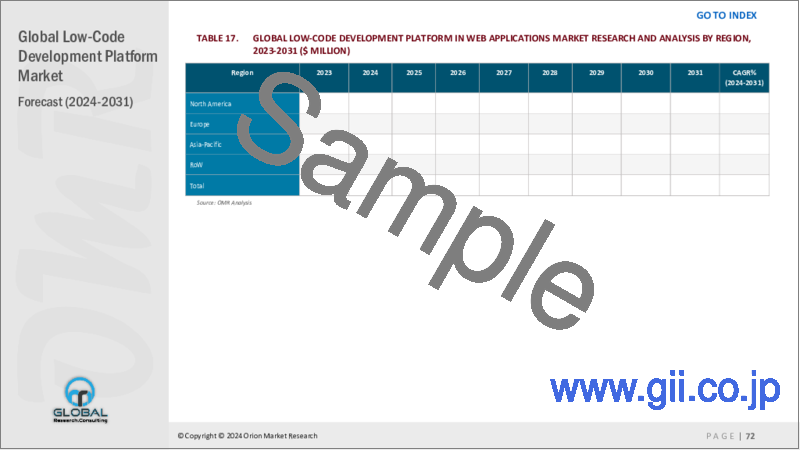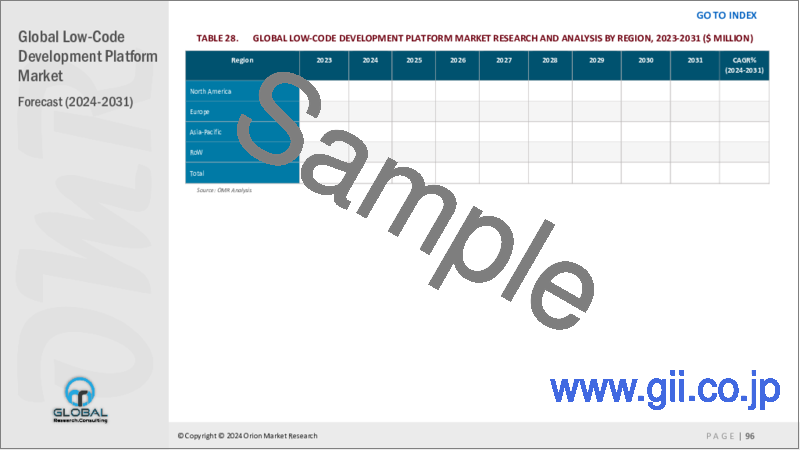|
|
市場調査レポート
商品コード
1433387
ローコード開発プラットフォーム(LCDP)の世界市場:2023-2030年Global Low-Code Development Platform Market 2023-2030 |
||||||
カスタマイズ可能
|
|||||||
| ローコード開発プラットフォーム(LCDP)の世界市場:2023-2030年 |
|
出版日: 2023年12月08日
発行: Orion Market Research
ページ情報: 英文 225 Pages
納期: 2~3営業日
|
全表示
- 概要
- 図表
- 目次
世界のローコード開発プラットフォーム(LCDP)市場は、予測期間(2023-2030年)にCAGR 26.4%で成長すると予測されます。ローコード開発プラットフォーム(LCDP)(LCDP)は、ユーザーがアプリケーションソフトウェアを作成できるグラフィカルユーザーインターフェース(GUI)です。ローコード開発プラットフォーム(LCDP)は、効率性、柔軟性、応答性、反復性を提供することで、ビジネスの俊敏性と生産性を高めることができます。市場拡大の主な要因は数多くあるが、主な要因の1つはIT専門家の不足です。この不足の結果、多数の熟練したIT専門家を必要とせずに、組織がソフトウェアアプリケーションを開発・展開できるソリューションに対するニーズが高まっています。LCDPは、このニーズに対応できるソフトウェアプラットフォームの一種です。LCDPは、技術者でないユーザが、豊富なコーディング知識なしにアプリケーションを作成することを容易にします。これは、ドラッグアンドドロップのインターフェイス、あらかじめ組み込まれたコンポーネント、および開発プロセスを簡素化するその他の機能を提供することによって行われます。
セグメント別展望
BFSIサブセグメントが世界のローコード開発プラットフォーム(LCDP)市場で大きなシェアを占めると予想される
業界別では、顧客関係管理(CRM)サブセグメントが世界のローコード開発プラットフォーム(LCDP)市場でかなりのシェアを占めると予想されます。BFSI業界は、顧客の進化するニーズに対応し、業務効率を高め、規制要件を遵守する必要性によって、急速なデジタル変革が進んでいます。LCDPは、新しいアプリケーションを開発・展開するための、より迅速でコスト効率の高い方法を提供し、BFSI組織にとって価値あるツールとなっています。顧客体験(CX)は、BFSI組織にとって最優先事項です。LCDPは、パーソナライズされたオムニチャネルアプリケーションの開発と展開を可能にすることで、BFSI組織がCXを向上させるのに役立ちます。BFSI業界は、熟練したITプロフェッショナルの不足に直面しています。LCDPは、技術者でないユーザーやビジネスエキスパートが、豊富なコーディング知識なしにアプリケーションを作成できるようにすることで、BFSI組織がこの不足に対処できるよう支援します。BFSI組織は、効率改善とコスト削減のために、手動プロセスの自動化をますます進めています。LCDPは、ロボティック・プロセス・オートメーション(RPA)やその他の自動化ソリューションを開発・展開するためのプラットフォームを提供することで、BFSI組織のプロセス自動化を支援することができます。
地域別展望
ローコード開発プラットフォーム(LCDP)の世界市場は、北米(米国、カナダ)、欧州(英国、イタリア、スペイン、ドイツ、フランス、その他欧州地域)、アジア太平洋地域(インド、中国、日本、韓国、その他アジア地域)、その他のアジア太平洋地域(中東とアフリカ、ラテンアメリカ)を含む地域別にさらに細分化されます。なかでも北米が市場の大半を占めています。北米はローコード開発プラットフォーム(LCDP)(LCDP)を早くから採用しており、Salesforce、Microsoft、Appian、Mendixなどの主要ベンダーがこの地域に本社を置いているからです。北米では、豊富なコーディング知識がなくてもビジネス上の問題を解決するアプリケーションを作成できる市民開発者の需要が高まっています。LCDPは、ユーザーフレンドリーなインターフェースとドラッグ&ドロップ機能を提供することで、この需要に応え、より幅広いユーザーがアクセスできるようにしています。
ローコード開発プラットフォーム(LCDP)の世界市場では、欧州地域が大きなCAGRで成長する見込み
欧州地域は、いくつかの要因によって、予測期間を通じて大幅なCAGRで著しい成長を遂げると予測されています。ベンダーがAI機能を取り入れることで、欧州のLCDP情勢は一変し、インテリジェントな自動化、予測分析、ユーザー体験の向上が可能になります。AIを搭載したLCDPは、反復タスクの自動化、リアルタイムの洞察の提供、ユーザー行動への適応を可能にし、組織に対する価値提案を強化しています。さらに、欧州のベンチャーキャピタルはLCDP新興企業に積極的に投資し、イノベーションと事業拡大を推進するために必要なリソースとサポートを提供しており、欧州LCDP市場の成長と発展をさらに後押ししています。
欧州の企業では、アプリケーション開発の迅速化、コスト削減、俊敏性の向上、イノベーションの拡大など、LCDPの利点に対する認識が高まっています。こうした意識の高まりが、業界を問わずLCDPソリューションの需要を促進しています。欧州各国政府は、経済成長と競争力にとっての技術導入の重要性を認識し、さまざまな産業でデジタル化の取り組みを積極的に推進しています。このような支援により、企業は政府のデジタル化目標に沿おうとするため、LCDPの採用に有利な環境が整いつつあります。
目次
第1章 レポート概要
- 現在の産業タイプ分析と成長ポテンシャルの展望
- 調査方法とツール
- 市場内訳
- セグメント別
- 地域別
第2章 市場概要と洞察
- 調査範囲
- アナリストの洞察と現在の市場動向
- 主な調査結果
- 推奨事項
- 結論
第3章 競合情勢
- 主要企業分析
- Appian Corporation Inc.
- 概要
- 財務分析
- SWOT分析
- 最近の動向
- Mendix Technology BV
- 会社概要
- 財務分析
- SWOT分析
- 最近の動向
- Microsoft Corp.
- 概要
- 財務分析
- SWOT分析
- 最近の動向
- OutSystems
- 概要
- 財務分析
- SWOT分析
- 最近の動向
- Salesforce, Inc.
- 概要
- 財務分析
- SWOT分析
- 最近の動向
- 主要戦略分析
第4章 市場セグメンテーション
- ローコード開発プラットフォーム(LCDP)の世界市場:展開タイプ別
- オンプレミス
- クラウド
- ローコード開発プラットフォーム(LCDP)の世界市場:ユーザータイプ別
- ビジネスユーザー
- ITプロフェッショナル
- ローコード開発プラットフォーム(LCDP)の世界市場:アプリケーションタイプ別
- Webアプリケーション
- モバイルアプリケーション
- ローコード開発プラットフォーム(LCDP)の世界市場:産業別
- BFSI
- ヘルスケア
- 製造
- 小売
- 政府
- 教育
- 情報通信技術(ICT)
- その他(輸送、物流、メディア・エンターテインメント)
第5章 地域分析
- 北米
- 米国
- カナダ
- 欧州
- 英国
- ドイツ
- イタリア
- スペイン
- フランス
- その他欧州
- アジア太平洋
- 中国
- インド
- 日本
- 韓国
- その他アジア太平洋地域
- 世界のその他の地域
第6章 企業プロファイル
- AgilePoint, INC.
- BRYTER GmbH
- Creatio.
- Kintone Southeast Asia Sdn. Bhd.
- LANSA INC.
- Newgen Software Technologies Ltd.
- Oracle
- Pegasystems Inc.
- Quickbase, Inc.
- Retool, Inc.
- Zoho Corporation Pvt. Ltd.
LIST OF TABLES
- 1. GLOBAL LOW-CODE DEVELOPMENT PLATFORM MARKET RESEARCH AND ANALYSIS BY DEPLOYMENT TYPE, 2023-2030 ($ MILLION)
- 2. GLOBAL ON-PREMISES LOW-CODE DEVELOPMENT PLATFORM MARKET RESEARCH AND ANALYSIS BY REGION, 2023-2030 ($ MILLION)
- 3. GLOBAL CLOUD-BASED LOW-CODE DEVELOPMENT PLATFORM MARKET RESEARCH AND ANALYSIS BY REGION, 2023-2030 ($ MILLION)
- 4. GLOBAL LOW-CODE DEVELOPMENT PLATFORM MARKET RESEARCH AND ANALYSIS BY USER TYPE, 2023-2030 ($ MILLION)
- 5. GLOBAL LOW-CODE DEVELOPMENT PLATFORM FOR BUSINESS USERS MARKET RESEARCH AND ANALYSIS BY REGION, 2023-2030 ($ MILLION)
- 6. GLOBAL LOW-CODE DEVELOPMENT PLATFORM FOR IT PROFESSIONALS MARKET RESEARCH AND ANALYSIS BY REGION, 2023-2030 ($ MILLION)
- 7. GLOBAL LOW-CODE DEVELOPMENT PLATFORM MARKET RESEARCH AND ANALYSIS BY APPLICATION TYPE, 2023-2030 ($ MILLION)
- 8. GLOBAL LOW-CODE DEVELOPMENT PLATFORM FOR WEB APPLICATIONS MARKET RESEARCH AND ANALYSIS BY REGION, 2023-2030 ($ MILLION)
- 9. GLOBAL LOW-CODE DEVELOPMENT PLATFORM FOR MOBILE APPLICATIONS MARKET RESEARCH AND ANALYSIS BY REGION, 2023-2030 ($ MILLION)
- 10. GLOBAL LOW-CODE DEVELOPMENT PLATFORM MARKET RESEARCH AND ANALYSIS BY INDUSTRY, 2023-2030 ($ MILLION)
- 11. GLOBAL LOW-CODE DEVELOPMENT PLATFORM FOR BFSI MARKET RESEARCH AND ANALYSIS BY REGION, 2023-2030 ($ MILLION)
- 12. GLOBAL LOW-CODE DEVELOPMENT PLATFORM FOR HEALTHCARE MARKET RESEARCH AND ANALYSIS BY REGION, 2023-2030 ($ MILLION)
- 13. GLOBAL LOW-CODE DEVELOPMENT PLATFORM FOR MANUFACTURING MARKET RESEARCH AND ANALYSIS BY REGION, 2023-2030 ($ MILLION)
- 14. GLOBAL LOW-CODE DEVELOPMENT PLATFORM FOR RETAIL MARKET RESEARCH AND ANALYSIS BY REGION, 2023-2030 ($ MILLION)
- 15. GLOBAL LOW-CODE DEVELOPMENT PLATFORM FOR GOVERNMENT MARKET RESEARCH AND ANALYSIS BY REGION, 2023-2030 ($ MILLION)
- 16. GLOBAL LOW-CODE DEVELOPMENT PLATFORM FOR EDUCATION MARKET RESEARCH AND ANALYSIS BY REGION, 2023-2030 ($ MILLION)
- 17. GLOBAL LOW-CODE DEVELOPMENT PLATFORM FOR ICT MARKET RESEARCH AND ANALYSIS BY REGION, 2023-2030 ($ MILLION)
- 18. GLOBAL LOW-CODE DEVELOPMENT PLATFORM FOR OTHERS MARKET RESEARCH AND ANALYSIS BY REGION, 2023-2030 ($ MILLION)
- 19. GLOBAL LOW-CODE DEVELOPMENT PLATFORM MARKET RESEARCH AND ANALYSIS BY REGION, 2023-2030 ($ MILLION)
- 20. NORTH AMERICAN LOW-CODE DEVELOPMENT PLATFORM MARKET RESEARCH AND ANALYSIS BY COUNTRY, 2023-2030 ($ MILLION)
- 21. NORTH AMERICAN LOW-CODE DEVELOPMENT PLATFORM MARKET RESEARCH AND ANALYSIS BY DEPLOYMENT TYPE, 2023-2030 ($ MILLION)
- 22. NORTH AMERICAN LOW-CODE DEVELOPMENT PLATFORM MARKET RESEARCH AND ANALYSIS BY USER TYPE, 2023-2030 ($ MILLION)
- 23. NORTH AMERICAN LOW-CODE DEVELOPMENT PLATFORM MARKET RESEARCH AND ANALYSIS BY APPLICATION TYPE, 2023-2030 ($ MILLION)
- 24. NORTH AMERICAN LOW-CODE DEVELOPMENT PLATFORM MARKET RESEARCH AND ANALYSIS BY INDUSTRY, 2023-2030 ($ MILLION)
- 25. EUROPEAN LOW-CODE DEVELOPMENT PLATFORM MARKET RESEARCH AND ANALYSIS BY COUNTRY, 2023-2030 ($ MILLION)
- 26. EUROPEAN LOW-CODE DEVELOPMENT PLATFORM MARKET RESEARCH AND ANALYSIS BY DEPLOYMENT TYPE, 2023-2030 ($ MILLION)
- 27. EUROPEAN LOW-CODE DEVELOPMENT PLATFORM MARKET RESEARCH AND ANALYSIS BY USER TYPE, 2023-2030 ($ MILLION)
- 28. EUROPEAN LOW-CODE DEVELOPMENT PLATFORM MARKET RESEARCH AND ANALYSIS BY APPLICATION TYPE, 2023-2030 ($ MILLION)
- 29. EUROPEAN LOW-CODE DEVELOPMENT PLATFORM MARKET RESEARCH AND ANALYSIS BY INDUSTRY, 2023-2030 ($ MILLION)
- 30. ASIA-PACIFIC LOW-CODE DEVELOPMENT PLATFORM MARKET RESEARCH AND ANALYSIS BY COUNTRY, 2023-2030 ($ MILLION)
- 31. ASIA-PACIFIC LOW-CODE DEVELOPMENT PLATFORM MARKET RESEARCH AND ANALYSIS BY DEPLOYMENT TYPE 2023-2030 ($ MILLION)
- 32. ASIA-PACIFIC LOW-CODE DEVELOPMENT PLATFORM MARKET RESEARCH AND ANALYSIS BY USER TYPE, 2023-2030 ($ MILLION)
- 33. ASIA-PACIFIC LOW-CODE DEVELOPMENT PLATFORM MARKET RESEARCH AND ANALYSIS BY APPLICATION TYPE, 2023-2030 ($ MILLION)
- 34. ASIA-PACIFIC LOW-CODE DEVELOPMENT PLATFORM MARKET RESEARCH AND ANALYSIS BY INDUSTRY, 2023-2030 ($ MILLION)
- 35. REST OF THE WORLD LOW-CODE DEVELOPMENT PLATFORM MARKET RESEARCH AND ANALYSIS BY REGION, 2023-2030 ($ MILLION)
- 36. REST OF THE WORLD LOW-CODE DEVELOPMENT PLATFORM MARKET RESEARCH AND ANALYSIS BY DEPLOYMENT TYPE, 2023-2030 ($ MILLION)
- 37. REST OF THE WORLD LOW-CODE DEVELOPMENT PLATFORM MARKET RESEARCH AND ANALYSIS BY USER TYPE, 2023-2030 ($ MILLION)
- 38. REST OF THE WORLD LOW-CODE DEVELOPMENT PLATFORM MARKET RESEARCH AND ANALYSIS BY APPLICATION TYPE, 2023-2030 ($ MILLION)
- 39. REST OF THE WORLD LOW-CODE DEVELOPMENT PLATFORM MARKET RESEARCH AND ANALYSIS BY INDUSTRY, 2023-2030 ($ MILLION)
LIST OF FIGURES
- 1. GLOBAL LOW-CODE DEVELOPMENT PLATFORM MARKET SHARE BY DEPLOYMENT TYPE, 2023 VS 2030 (%)
- 2. GLOBAL ON-PREMISES LOW-CODE DEVELOPMENT PLATFORM MARKET SHARE BY REGION, 2023 VS 2030 (%)
- 3. GLOBAL CLOUD-BASED LOW-CODE DEVELOPMENT PLATFORM MARKET SHARE BY REGION, 2023 VS 2030 (%)
- 4. GLOBAL LOW-CODE DEVELOPMENT PLATFORM MARKET SHARE BY USER TYPE, 2023 VS 2030 (%)
- 5. GLOBAL LOW-CODE DEVELOPMENT PLATFORM FOR BUSINESS USERS MARKET SHARE BY REGION, 2023 VS 2030 (%)
- 6. GLOBAL LOW-CODE DEVELOPMENT PLATFORM FOR IT PROFESSIONALS MARKET SHARE BY REGION, 2023 VS 2030 (%)
- 7. GLOBAL LOW-CODE DEVELOPMENT PLATFORM MARKET SHARE ANALYSIS BY APPLICATION TYPE, 2023-2030 ($ MILLION)
- 8. GLOBAL LOW-CODE DEVELOPMENT PLATFORM FOR WEB APPLICATIONS MARKET SHARE BY REGION, 2023 VS 2030 (%)
- 9. GLOBAL LOW-CODE DEVELOPMENT PLATFORM FOR MOBILE APPLICATIONS MARKET SHARE BY REGION, 2023 VS 2030 (%)
- 10. GLOBAL LOW-CODE DEVELOPMENT PLATFORM MARKET SHARE ANALYSIS BY INDUSTRY, 2023-2030 ($ MILLION)
- 11. GLOBAL LOW-CODE DEVELOPMENT PLATFORM FOR BFSI MARKET SHARE BY REGION, 2023 VS 2030 (%)
- 12. GLOBAL LOW-CODE DEVELOPMENT PLATFORM FOR HEALTHCARE MARKET SHARE BY REGION, 2023 VS 2030 (%)
- 13. GLOBAL LOW-CODE DEVELOPMENT PLATFORM FOR MANUFACTURING MARKET SHARE BY REGION, 2023 VS 2030 (%)
- 14. GLOBAL LOW-CODE DEVELOPMENT PLATFORM FOR RETAIL MARKET SHARE BY REGION, 2023 VS 2030 (%)
- 15. GLOBAL LOW-CODE DEVELOPMENT PLATFORM FOR GOVERNMENT MARKET SHARE BY REGION, 2023 VS 2030 (%)
- 16. GLOBAL LOW-CODE DEVELOPMENT PLATFORM FOR EDUCATION MARKET SHARE BY REGION, 2023 VS 2030 (%)
- 17. GLOBAL LOW-CODE DEVELOPMENT PLATFORM FOR ICT MARKET SHARE BY REGION, 2023 VS 2030 (%)
- 18. GLOBAL LOW-CODE DEVELOPMENT PLATFORM FOR OTHERS MARKET SHARE BY REGION, 2023 VS 2030 (%)
- 19. GLOBAL LOW-CODE DEVELOPMENT PLATFORM MARKET SHARE BY REGION, 2023 VS 2030 (%)
- 20. US LOW-CODE DEVELOPMENT PLATFORM MARKET SIZE, 2023-2030 ($ MILLION)
- 21. CANADA LOW-CODE DEVELOPMENT PLATFORM MARKET SIZE, 2023-2030 ($ MILLION)
- 22. UK LOW-CODE DEVELOPMENT PLATFORM MARKET SIZE, 2023-2030 ($ MILLION)
- 23. FRANCE LOW-CODE DEVELOPMENT PLATFORM MARKET SIZE, 2023-2030 ($ MILLION)
- 24. GERMANY LOW-CODE DEVELOPMENT PLATFORM MARKET SIZE, 2023-2030 ($ MILLION)
- 25. ITALY LOW-CODE DEVELOPMENT PLATFORM MARKET SIZE, 2023-2030 ($ MILLION)
- 26. SPAIN LOW-CODE DEVELOPMENT PLATFORM MARKET SIZE, 2023-2030 ($ MILLION)
- 27. REST OF EUROPE LOW-CODE DEVELOPMENT PLATFORM MARKET SIZE, 2023-2030 ($ MILLION)
- 28. INDIA LOW-CODE DEVELOPMENT PLATFORM MARKET SIZE, 2023-2030 ($ MILLION)
- 29. CHINA LOW-CODE DEVELOPMENT PLATFORM MARKET SIZE, 2023-2030 ($ MILLION)
- 30. JAPAN LOW-CODE DEVELOPMENT PLATFORM MARKET SIZE, 2023-2030 ($ MILLION)
- 31. SOUTH KOREA LOW-CODE DEVELOPMENT PLATFORM MARKET SIZE, 2023-2030 ($ MILLION)
- 32. REST OF ASIA-PACIFIC LOW-CODE DEVELOPMENT PLATFORM MARKET SIZE, 2023-2030 ($ MILLION)
- 33. REST OF THE WORLD LOW-CODE DEVELOPMENT PLATFORM MARKET SIZE, 2023-2030 ($ MILLION)
Global Low-code Development Platform Market Size, Share & Trends Analysis Report by Deployment Type (On-Premises, and Cloud Based), by User Type (Business users, and IT professionals), by Application Type (Web applications, and Mobile applications), and by Industry (BFSI, Healthcare, Manufacturing, Retail, Government, Education, ICT, and Others (Transportation, Logistics, and Media and Entertainment))Forecast Period (2023-2030)
The global low-code development platform market is anticipated to grow at a CAGR of 26.4% during the forecast period (2023-2030). A low-code development platform (LCDP) is a graphical user interface (GUI) that allows users to create application software. Low-code development platforms can help businesses become more agile and productive by providing, efficiency, flexibility, responsiveness, and iterability. There are many key drivers for the increase in the market, but one of the primary drivers is the shortage of IT professionals. As a result of this shortage, there is a growing need for solutions that can help organizations develop and deploy software applications without the need for a large number of skilled IT professionals. LCDPs are a type of software platform that can help to address this need. LCDPs make it easier for non-technical users to create applications without extensive coding knowledge. This is done by providing a drag-and-drop interface, pre-built components, and other features that simplify the development process.
Segmental Outlook
The global low-code development platform market is segmented on the deployment type, user type, application type, and industry. Based on the deployment type, the market is sub-segmented into on-premises, and cloud based. Based on the user type, the market is sub-segmented into business users and IT professionals. Based, on the basis of application type, the market is sub-segmented into web applications and mobile applications. Further, based on the industry the market is sub-segmented into BFSI, healthcare, manufacturing, retail, government, education, ICT, and others.
The BFSI Sub-Segment is Anticipated to Hold a Considerable Share of the Global Low-code Development Platform Market
Among the Industry, the customer relationship management (CRM) sub-segment is expected to hold a considerable share of the global low-code development platform market. The BFSI industry is undergoing rapid digital transformation, driven by the need to meet the evolving needs of customers, enhance operational efficiency, and comply with regulatory requirements. LCDPs provide a faster and more cost-effective way to develop and deploy new applications, making them a valuable tool for BFSI organizations. Customer experience (CX) is a top priority for BFSI organizations. LCDPs can help BFSI organizations improve CX by enabling them to develop and deploy personalized and omnichannel applications. The BFSI industry faces a shortage of skilled IT professionals. LCDPs can help BFSI organizations address this shortage by enabling non-technical users and business experts to create applications without extensive coding knowledge. BFSI organizations are increasingly automating manual processes to improve efficiency and reduce costs. LCDPs can help BFSI organizations automate processes by providing a platform for developing and deploying robotic process automation (RPA) and other automation solutions.
Regional Outlook
The global low-code development platform market is further segmented based on geography including North America (the US, and Canada), Europe (UK, Italy, Spain, Germany, France, and the Rest of Europe), Asia-Pacific (India, China, Japan, South Korea, and Rest of Asia), and the Rest of the World (the Middle East & Africa, and Latin America). Among these, North America holds the majority of the market. This is because North America has been an early adopter of Low-Code Development Platforms (LCDPs), with several major vendors, such as Salesforce, Microsoft, Appian, and Mendix, headquartered in the region. North America has a growing demand for citizen developers, empowered individuals who can create applications to solve business problems without extensive coding knowledge. LCDPs cater to this demand by providing user-friendly interfaces and drag-and-drop functionality, making them accessible to a broader range of users.
The European Region is Expected to Grow at a Significant CAGR in the Global Low-code Development Platform Market
The European region is projected to experience significant growth at a substantial CAGR throughout the projected period, driven by several factors. The incorporation of AI capabilities by vendors is transforming the LCDP landscape in Europe, enabling intelligent automation, predictive analytics, and enhanced user experiences. AI-powered LCDPs can automate repetitive tasks, provide real-time insights, and adapt to user behavior, enhancing their value proposition for organizations. Additionally, European venture capital firms are actively investing in LCDP startups, providing them with the necessary resources and support to drive innovation and expansion, further fueling growth and development in the European LCDP market.
European organizations are becoming increasingly aware of the benefits of LCDPs, including faster application development, reduced costs, improved agility, and increased innovation. This growing awareness is driving demand for LCDP solutions across industries. European governments are actively promoting digitalization initiatives across various industries, recognizing the importance of technology adoption for economic growth and competitiveness. This support creates a favorable environment for the adoption of LCDPs, as organizations seek to align with government digitalization goals.
Market Players Outlook
The major companies serving the low-code development platform market include Appian Corp. Inc., Mendix Technology BV, Microsoft, OutSystems, Salesforce, Inc., and others. The market players are considerably contributing to the market growth by the adoption of various strategies including mergers and acquisitions, partnerships, collaborations, funding, and new product launches, to stay competitive in the market. For instance, in March 2022 Zoho launched the upgraded version of its Low-Code Platform named Zoho Creator. With this update the platform combined application development, business intelligence and analytics, and process automation among others into one single platform, while simultaneously helping IT teams to manage security, compliance, and governance.
The Report Covers:
- Market value data analysis of 2022 and forecast to 2030.
- Annualized market revenues ($ million) for each market segment.
- Country-wise analysis of major geographical regions.
- Key companies operating in the global low-code development platform market. Based on the availability of data, information related to new product launches, and relevant news is also available in the report.
- Analysis of business strategies by identifying the key market segments positioned for strong growth in the future.
- Analysis of market-entry and market expansion strategies.
- Competitive strategies by identifying 'who-stands-where' in the market.
Table of Contents
1. Report Summary
- Current Industry Type Analysis and Growth Potential Outlook
- 1.1. Research Methods and Tools
- 1.2. Market Breakdown
- 1.2.1. By Segments
- 1.2.2. By Region
2. Market Overview and Insights
- 2.1. Scope of the Report
- 2.2. Analyst Insight & Current Market Trends
- 2.2.1. Key Findings
- 2.2.2. Recommendations
- 2.2.3. Conclusion
3. Competitive Landscape
- 3.1. Key Company Analysis
- 3.2. Appian Corporation Inc.
- 3.2.1. Overview
- 3.2.2. Financial Analysis
- 3.2.3. SWOT Analysis
- 3.2.4. Recent Developments
- 3.3. Mendix Technology BV
- 3.3.1. Overview
- 3.3.2. Financial Analysis
- 3.3.3. SWOT Analysis
- 3.3.4. Recent Developments
- 3.4. Microsoft Corp.
- 3.4.1. Overview
- 3.4.2. Financial Analysis
- 3.4.3. SWOT Analysis
- 3.4.4. Recent Developments
- 3.5. OutSystems
- 3.5.1. Overview
- 3.5.2. Financial Analysis
- 3.5.3. SWOT Analysis
- 3.5.4. Recent Developments
- 3.6. Salesforce, Inc.
- 3.6.1. Overview
- 3.6.2. Financial Analysis
- 3.6.3. SWOT Analysis
- 3.6.4. Recent Developments
- 3.7. Key Strategy Analysis
4. Market Segmentation
- 4.1. Global Low-Code Development Platform Market by Deployment Type
- 4.1.1. On-Premises
- 4.1.2. Cloud
- 4.2. Global Low-Code Development Platform Market by User Type
- 4.2.1. Business Users
- 4.2.2. IT Professionals
- 4.3. Global Low-Code Development Platform Market by Application Type
- 4.3.1. Web Applications
- 4.3.2. Mobile Applications
- 4.4. Global Low-Code Development Platform Market by Industry
- 4.4.1. BFSI
- 4.4.2. Healthcare
- 4.4.3. Manufacturing
- 4.4.4. Retail
- 4.4.5. Government
- 4.4.6. Education
- 4.4.7. Information and Communication Technology (ICT)
- 4.4.8. Others (Transportation, Logistics, and Media and Entertainment)
5. Regional Analysis
- 5.1. North America
- 5.1.1. United States
- 5.1.2. Canada
- 5.2. Europe
- 5.2.1. UK
- 5.2.2. Germany
- 5.2.3. Italy
- 5.2.4. Spain
- 5.2.5. France
- 5.2.6. Rest of Europe
- 5.3. Asia-Pacific
- 5.3.1. China
- 5.3.2. India
- 5.3.3. Japan
- 5.3.4. South Korea
- 5.3.5. Rest of Asia-Pacific
- 5.4. Rest of the World
6. Company Profiles
- 6.1. AgilePoint, INC.
- 6.2. BRYTER GmbH
- 6.3. Creatio.
- 6.4. Kintone Southeast Asia Sdn. Bhd.
- 6.5. LANSA INC.
- 6.6. Newgen Software Technologies Ltd.
- 6.7. Oracle
- 6.8. Pegasystems Inc.
- 6.9. Quickbase, Inc.
- 6.10. Retool, Inc.
- 6.11. Zoho Corporation Pvt. Ltd.






